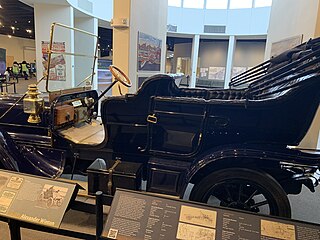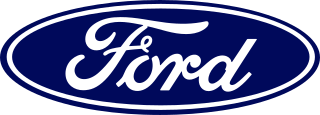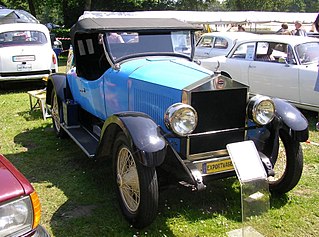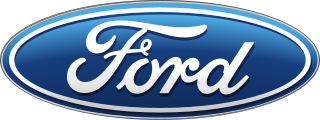Related Research Articles

Opel Automobile GmbH is a German automobile manufacturer, a subsidiary of French automaker Groupe PSA since August 2017. From 1929 until 2017, Opel was owned by American automaker General Motors. Opel vehicles are sold in Great Britain under the Vauxhall brand. Some Opel vehicles were badge-engineered in Australia under the Holden brand until 2017 namely Commodore & Senator and in North America and China under the Buick, Saturn, and Cadillac brands.
The REO Motor Car Company was a Lansing, Michigan-based company that produced automobiles and trucks from 1905 to 1975. At one point the company also manufactured buses on its truck platforms.

The McLaughlin Motor Car Company Limited was a Canadian manufacturer of automobiles headquartered in Oshawa, Ontario. It became General Motors of Canada.

The Winton Motor Carriage Company was a pioneer United States automobile manufacturer based in Cleveland, Ohio. Winton was one of the first American companies to sell a motor car. In 1912 Winton became one of the first American manufacturers of diesel engines.

MG is a British Automotive marque founded by Cecil Kimber in the 1920s, and M.G. Car Company Limited was the British sports car manufacturer that made the marque famous. Best known for its 'midget' open two-seater sports cars, MG also produced saloons and coupés, with engines up to three litres in size. The marque is now owned by Chinese automotive giant SAIC Motor Corporation Limited.

Studebaker was an American wagon and automobile manufacturer based in South Bend, Indiana. Founded in 1852 and incorporated in 1868 as the Studebaker Brothers Manufacturing Company, the firm was originally a producer of wagons, buggies, carriages and harnesses. Studebaker continued to manufacture other diversified products after automobile production ceased in 1966.

Badge engineering, sometimes called rebadging, is the practice of applying a different badge or trademark to an existing product and subsequently marketing the variant as a distinct product. Due to the high cost of designing and engineering a new model or establishing a brand, economies of scale make it less expensive to rebadge a product once or multiple times than to create different models.

Daewoo Motors was a South Korean automotive company established in 1983, part of the Daewoo Group. It sold most of its assets in 2001 to General Motors, after running into financial difficulties, becoming a subsidiary of the American company and in 2011, it was replaced by GM Korea.

The Peerless Motor Car Company was an American automobile manufacturer that produced the Peerless brand of motorcars in Cleveland, Ohio, from 1900 to 1931. One of the "Three Ps" – Packard, Peerless, and Pierce-Arrow – the company was known for building high-quality luxury automobiles. Peerless popularized a number of vehicle innovations that later became standard equipment, including drum brakes and the first enclosed-body production cars.

Ford Motor Company of Canada Ltd. was founded on August 17, 1904, for the purpose of manufacturing and selling Ford automobiles in Canada and the British Empire. It was originally known as the Walkerville Wagon Works, and was located in Walkerville, Ontario. The founder, Gordon McGregor, convinced a group of investors to invest in Henry Ford's new automobile which was being produced across the river in Detroit.
Dongfeng Motor Company Limited is an automobile manufacturing company headquartered in Wuhan, China. It is a 50–50 joint-venture between Dongfeng Motor Group and Nissan Motors. It produces passenger cars under the Nissan marque and commercial vehicles under the Dongfeng marque.

Moon Motor Car Company was an American automobile company that was located in St. Louis, Missouri. The company had a venerable reputation among the buying public, as it was known for fully assembled, easily affordable mid-level cars using high-quality parts. Often this meant the manufacturing process required more human intervention, leading to operating losses.

Ford-Werke GmbH is a German car manufacturer headquartered in Niehl, Cologne, North Rhine-Westphalia and a subsidiary of Ford of Europe, which in turn is a subsidiary of Ford Motor Company.

Australian Motor Industries (AMI) was an automobile assembly firm that was significant in the early history of the automotive industry in Australia.
The Diana Motors Company was an early United States automobile manufacturing company. The company produced automobiles from 1925 to 1928. The St. Louis based company was a subsidiary of the Moon Motor Car company. The company did not source its own components, rather, it produced "assembled" cars out of third party components. As of 2011, there were 12 known remaining vehicles produced by the company.

BAIC Group is a Chinese state-owned enterprise and holding company of several automobile and machine manufacturers located in Beijing, China.

The automotive industry in the United States began in the 1890s and, as a result of the size of the domestic market and the use of mass production, rapidly evolved into the largest in the world. However, the United States was overtaken as the largest automobile producer by Japan in the 1980s, and subsequently by China in 2008. The U.S. is currently second among the largest manufacturer in the world by volume, with approximately 8-10 million manufactured annually. Notable exceptions were 5.7 million automobiles manufactured in 2009, and peak production levels of 13-15 million units during the 1970s and early 2000s.

A substantial car industry was created in Australia in the 20th century through the opening of Australian plants by international manufacturers. The first major carmaker was Ford Australia and the first Australian-designed mass production car was manufactured by Holden in 1948. Australian manufacture of cars rose to a maximum of almost half a million in the 1970s and still exceeded 400,000 in 2004. Australia was best known for the design and production of 'large' sized passenger vehicles. By 2009 total production had fallen to around 175,000 and the Australian market was dominated by cars imported from Asia and Europe.
The Taiwanese Prince Motors Co. was established on 6 July, 1965 by Hsu Sheng-fa. Initially, Prince Motors Co. imported chassis and assembles commercial vehicles and utility trucks and was the main procuration of the Japanese Komatsu and Mitsubishi Kato trucks. Starting from 1971, Prince Motors Co. also produced Nissan Homer commercial vehicles for Nissan and further introduced products labelled YLN-251, 252, 253, 255 under the sales partner of Yulon Nissan in Taiwan.

Automotive industry in Vietnam is a fast growing sector, mainly reliant on domestic sales. All currently produced models are designed abroad by foreign brands, and many rely on knock-down kit production. Due to high import taxes on automobiles, the Vietnamese government protects domestic manufacturing. Although Vietnam is a member of the ASEAN Free Trade Area, automobile imports fall under an exception. Since January 1, 2018, the 30% import tax has been discontinued as part of ASEAN agreements. Currently, the Vietnamese motor industry is not deemed competitive enough to make exports feasible. As of April 2018, 85% of car sales in Vietnam were produced domestically from CKD kits.
References
McConnell, Curt (1995). Great Cars of the Great Plains. University of Nebraska Press. ISBN 0-8032-3163-6
| This article about classic and vintage automobiles produced between 1915 and 1930 is a stub. You can help Wikipedia by expanding it. |